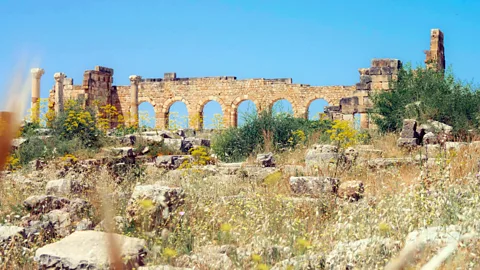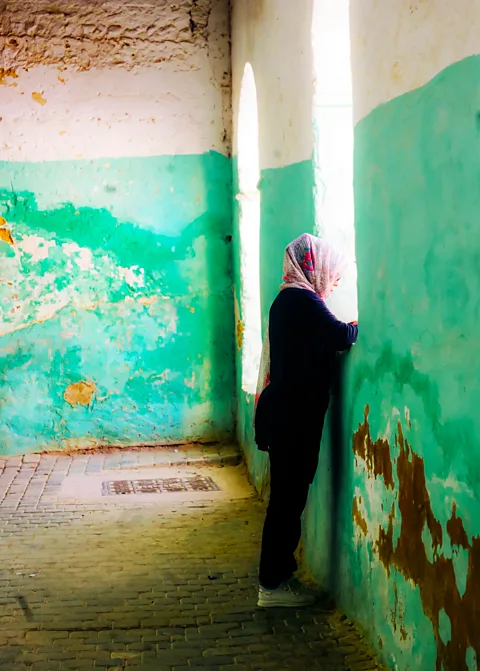Once closed to outsiders and long overshadowed by Morocco’s more famous cities, Moulay Idriss is now quietly welcoming curious travelers. With its sacred past, winding alleyways, and riot of pastel colors, this hillside town offers an authentic slice of Moroccan life—and a contemplative retreat far from the usual tourist paths.
A hidden jewel among the Rif Mountains

Perched at the base of Mount Zerhoune in northern Morocco, Moulay Idriss awakens slowly with the dawn. On a May morning, I rise to the distant crow of roosters and set out through the town’s hushed streets. As the sun peeks over the hills, its light spills across pastel walls in hues of mint, coral, violet, and lemon—colors that glow softly against the whitewashed facades.

Moulay Idriss lies just three hours from the famed blue city of Chefchaouen, yet it feels worlds apart. Once closed to non-Muslims until the early 20th century, the town’s sacred status has kept it largely untouched by mass tourism. Still, it holds immense spiritual importance for Moroccans. “If you visit Moulay Idriss five times, it’s considered the same as going to Mecca,” my guide, Imad El-Meloudi, tells me. He beams with pride as he adds, “We want the world to know this place.”
Between history and holiness

Moulay Idriss’s roots stretch back to 786 CE, when Idris I—great-grandson of the Prophet Muhammad—fled to Morocco following a failed uprising. He established his base at the Roman ruins of Volubilis and began spreading Islam throughout the region. After his death, followers built their homes around his tomb, and a town slowly took shape over centuries.
Today, Volubilis remains an evocative presence just a few kilometers from the town. Among yellow wildflowers and olive groves, remnants of Roman columns, mosaic floors, and ancient public baths stand as reminders of a once-thriving empire. “There were rivers here once,” says Khalid, a local guide. “People settled for the fertility of the land. They had everything.”
Sanctity preserved, traditions honored

Moulay Idriss quickly became Morocco’s most important religious town, and its sanctity was zealously guarded. Until 1912, non-Muslims were forbidden to enter, and it wasn’t until 2005 that overnight stays were permitted—part of a wider initiative by King Mohammed VI to foster cultural exchange and invite the world to discover Morocco’s heritage.
Yet the town still holds tightly to its spiritual core. A wooden pole across the entrance of the mosque blocks further passage to non-Muslims, though from the archway one can glimpse the pristine white marble floor that leads into the mausoleum of Idris I. The experience is quiet and humbling, a reminder that even as it opens up, Moulay Idriss retains its sense of sacred privacy.
Echoes of prayer and pilgrimage
As the call to prayer resonates through the narrow streets, I follow my host, Hajiba Dahik, through an alleyway that leads to a discreet overlook above the mosque. We pause near a green-and-white tiled corridor, watching worshippers make their way to prayer. “During Ramadan, these walkways are packed,” she says. “And in August, during the festival honoring Moulay Idriss, people come from all over Morocco—some sleep on the floor, just to be near the mausoleum.”
That deep reverence lives not only in the town’s sacred spaces but also in its architecture, customs, and everyday rhythms. Moulay Idriss is a living tribute to Morocco’s Islamic history—one that continues to draw pilgrims, not just tourists.
The round minaret and the art of distinction

Climbing up a steep path, I spot a unique sight: a round, emerald-green minaret adorned with white Kufic-scripted verses from the Quran. A pair of boys shout out, “La Grande Terrasse? Le minaret? Five minutes!” and point me onward.
This is the Al-Santisi Mosque, whose cylindrical minaret—built in 1939 by architect Hajj Idris Al-Santisi—is believed to be the only one of its kind in Morocco. While most North African minarets are square, this design sets Moulay Idriss apart. Green and white, colors representing paradise and purity in Islam, give the structure a quiet majesty as it rises above the town’s rooftops.
A watercolour cityscape
The upper reaches of the town unfold like a painter’s palette. Homes and staircases are drenched in seafoam green, dusty rose, butter yellow, and sky blue. Unlike Chefchaouen, where blue dominates by decree and tradition, the colors here reflect personal expression. “The people choose,” says El-Meloudi. “It doesn’t have to be blue. They paint what they feel.”
But two hues do stand out above all: white and green. Almost everyone agrees these colors dominate for a reason—peace and faith. In this way, even the walls seem to whisper prayers, echoing the spiritual life at the heart of Moulay Idriss.
Sacred creatures and slow living
As I wander through alleyways, I begin to notice that cats outnumber people. Orange tabbies stretch out on sunny steps, black cats curl in the shade of mint-green doors, and kittens tumble through blue corridors. “In Islam, cats are sacred,” explains Madiha Alfi, a guide from nearby Meknes. “They are clean, gentle, and loved by the Prophet.”
Donkeys, too, are part of daily life here. But unlike in Marrakech or Fes, where they’re often used to ferry tourists, these animals remain essential to local labor. “They help with olive harvests, and they carry groceries up the hills,” says El-Meloudi. In a town with few cars and many steep climbs, traditional tools still hold their value.
Life in the square
By sunset, the town converges in the main square. Beneath jacaranda trees bursting with purple flowers, locals sip mint tea and coffee. Children play football on cobbled lanes while women, seated on plastic chairs, adorn each other’s feet with delicate henna designs. Men in striped djellabas stroll across the square, exchanging greetings and news.
Just around the corner, vendors display baskets filled with seasonal fruits—mulberries, peaches, plums—and herbs fragrant in the warm dusk air. The scent of grilled kefta and fire-roasted corn wafts through the alleyways, turning the town into a sensory feast.
Sunset over spirit and stone
As the heat fades, I hike toward the outskirts of town for one last look. I pass bubbling streams and ancient Roman baths, and finally perch beneath an olive tree on a hillside. From here, the town stretches across two rugged hills like a jewel-box village, glowing in the golden light of dusk.
It’s hard to imagine a more quietly magical place. In a world of curated travel and filtered experiences, Moulay Idriss stands apart: real, reverent, and full of life. As El-Meloudi had said earlier, “If you knock on someone’s door, they’ll invite you in for tea.” In this technicolour town where past and present merge, the spirit of hospitality is not just a tradition—it’s a way of life.




